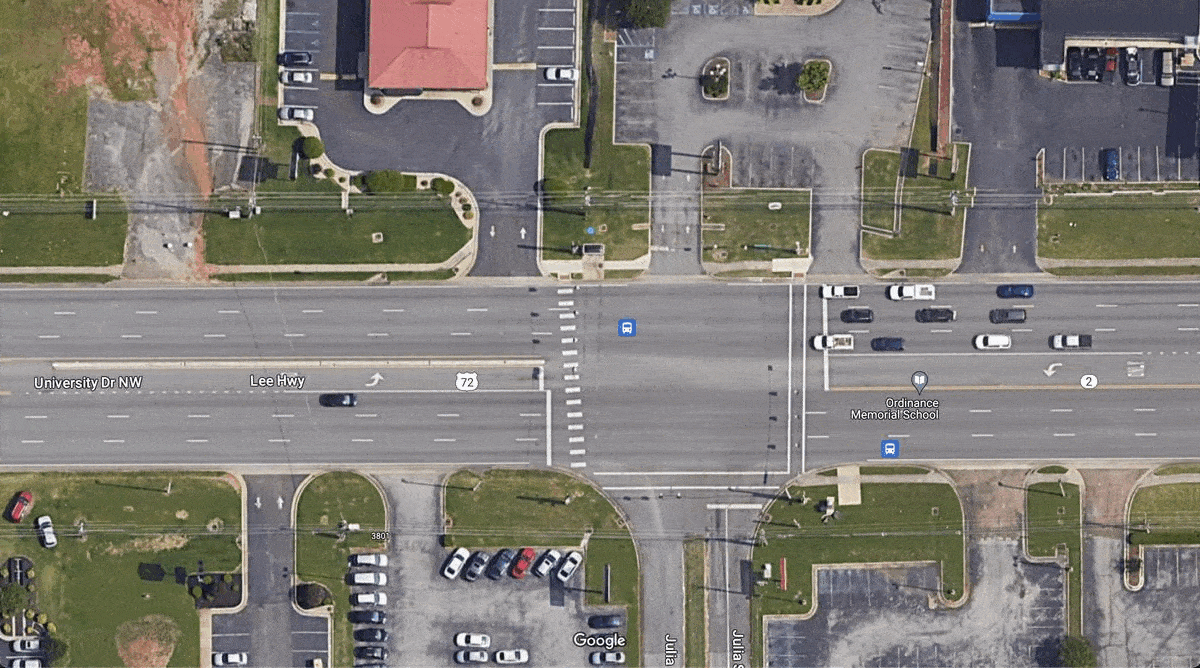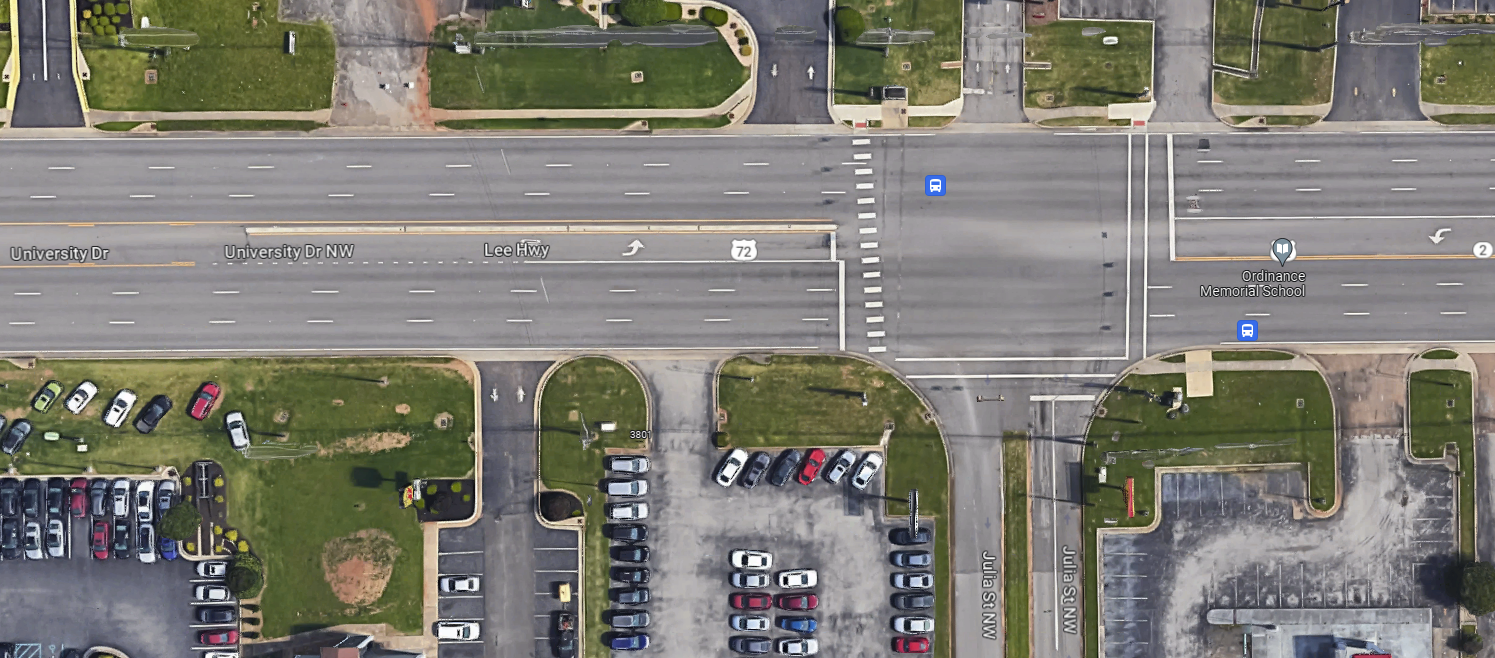Is There Hope for University Drive in Huntsville, Alabama?
University Drive in Huntsville, AL.
University Drive in Huntsville, Alabama, stretches seven lanes, with driveways for anything from Olive Garden to DriveTime dotting its perimeter. Along most of it, there are also bus stops and sidewalks. The latter is even pockmarked with ADA-compliant warning pads, brightly colored textured strips that notify those walking and rolling that the sidewalk is about to meet the street.
Yet, University Drive is neither conducive to walking nor a safe place to be outside of a vehicle. When Joshua Gurley was fatally struck while riding a bike along the road on June 7, 2021, that truth became even more apparent. Until the road and the land use around it radically change, locals fear tragedies like the one in 2021 will become more commonplace on University Drive. Warning pads are not enough.
To Larry Mason, University Drive is a textbook stroad. “It supports high speeds, but at the same time, the strip malls and big box stores mean lots of folks are turning in and out of driveways and parking lot entrances,” he explained.
Mason is a Huntsville resident who actually nominated the intersection of University Drive and Julia Street on which Gurley was killed to the Strong Towns Crash Analysis Studio. In advance of the Studio, he even conducted a speed study at the site and learned that over 60% of motorists in a 50-minute period drive in excess of the 45 mph speed limit. The chances of surviving being struck by a vehicle operating at the posted speed limit are already extremely slim, and that figure plummets the faster the vehicle travels.
The combined results of Mason’s speed study.
Huntsville Is Trying, But Is It Trying Hard Enough?
To Huntsville’s credit, University Drive has undergone marginal transformations. In 2019, a driveway—one of two taking prospective patrons in and out of Avis and Salon Elite—was supplanted by a sidewalk. It was one of several driveways filled in that year. Buffers were also installed along the middle turning lanes west of Julia street.
Even in 2022, months after the aforementioned crash, local traffic engineer Dario Gonzalez observed changes to the intersection. It’s unknown whether the crash catalyzed the changes, though he and others speculate that the bus stop’s relocation is more likely behind the updates.
With Huntsville’s upgrades to the area, one feature stood out: ADA compliance. “You see that pedestrian pad that was placed there on the east at the north end of the East crosswalk?” Gonzalez pointed out. “The only reason that they put that there was for ADA compliance.”
Following ADA guidelines is federally mandated, so it’s no surprise Huntsville added ramps, warning pads—what Gonzalez referred to as pedestrian pads—and so on. Yet, on a stroad like this, ADA compliance looks misplaced. It signals safety where there is none. It also appears incomplete. Gonzalez points to the location of the pedestrian beg button on the corner of Julia Street. “If you're coming down the sidewalk, and you want to hit that pedestrian button that's right there, that should be at the sidewalk. You shouldn't have to leave the sidewalk to go hunt for it.”
An inconvenience for a pedestrian could easily spiral into an impossibility for anyone with the type of mobility needs ADA compliant features are supposed to accommodate. Though, an awkwardly placed beg button may be the least University Drive’s challenges. “There’s no sidewalk here,” Gonzalez says, pointing to the southwestern side of the intersection.
The sidewalk drops off and doesn’t pick back up across the street. There’s even a zebra crossing that directs prospective walkers to a place with no pedestrian refuge. The few people who do walk here likely walk on the grass, to their inconvenience. Yet, what this design asks of those traveling on foot—or in a wheelchair, for example—is to cross University Drive twice to walk a single block, from [restaurant] to [restaurant]. “This isn’t built for people walking,” Gonzalez concluded.
“Nobody Walks Here”
University Drive looks like one of those places where elected leaders, city officials, and even other residents assume “nobody walks.” The Bob Michel Bridge in Peoria, Illinois—the subject of Seairra Jones’s piece, “Who Walks in the Unwalkable Places?”—was one of these places. In the case of Peoria, it turns out that people don’t choose the bridge out of desperation. Hundreds cross it routinely to get to work, run errands, and get some air. For many Jones interviewed, the bridge is convenient, even if it is dangerous.
Gonzalez and Huntsville native and bike advocate, Ben Payment, admit to avoiding University Drive when they can. Payment even laughed when asked whether he ever chooses the road for his daily bike commute. He lives just down the road from where the fatal crash took place in 2021. So, in a sense, it’s true that those who live closest to it avoid University Drive.
But that doesn’t mean nobody walks on it. In fact, Payment pointed out how many people don’t have a choice. “The only outlet for this whole housing area is basically the scene of the crash,” he explained, circling a residential community northwest of the crash site. “And you see the same thing here to the south. There are no small feeder roads, even. You’ve just got neighborhoods dumping straight into a major arterial, a highway basically.”
That residential pocket is feet from a gas station market, Family Dollar, and thrift store—retail many people can and do access by foot. The walk, however, involves crossing University Drive which “feels like playing Frogger.” The residential cul-de-sacs themselves are devoid of amenities, namely because of restrictive zoning, and so anyone in need of milk or a meal needs to interact with the stroad,” Payment said. “They’re forcing all [road] users to use infrastructure designed for cars.”
Residential pockets aren’t the only thing producing pedestrians. An improved bus network, something Huntsville’s inhabitants are excited about, may generate more people accessing University Drive’s big-box stores or the homes on its periphery on foot. At the very least, Huntsville is investing in that future.
“This is more of a place you want to get through rather than get to,” Payment countered. Yet passengers are still expected to be served in this area. “I wouldn't be surprised if you have more people darting across to catch the bus.”
Unless the improved bus system comes with a reimagining of University Drive, he and Gonzalez fear that the pedestrian crash rate will only get worse. Between 2015 and 2022, Gonzalez noted University Drive witnessed 62 pedestrian crashes and 16 bicycle crashes, numbers far above those of similar roads in the city. For comparison, the road with the second highest number of pedestrian crashes in the same period was Memorial Parkway with 33 crashes, nearly half that of University Drive.
Can University Drive Be Fixed?
With all of its identifiable problems, envisioning a different University Drive is almost impossible. “It’s called University Drive, but it’s also known as U.S. Highway 72,” Payment mentioned. “That’s part of the problem.”
Payment has a point. When University Drive was scrutinized during the Crash Analysis Studio, Melany Alliston of Toole Design, highlighted that its signage, lane widths, and overall design suggest it’s meant to function as a highway more than a connection to commerce. “The overall character [of this road] through its visual cues is that it is a highway to connect to other highways.”
Unlike other highways, however, University Drive can’t promise speed or seamlessness because it offers too many points of conflict. It puts people walking in the path of those driving and it puts those driving to the restaurants and businesses on its periphery in conflict with those driving through the area at 50 mph. Like the prototypical stroad, it tries to negotiate two incompatible experiences, in the end offering something not only suboptimal, but dangerous.
“If they want to keep this a highway, then other road users should be discouraged from going on it,” Edward Erfurt, Strong Towns’ Director of Community Action remarked after examining the road’s design. “But they have to decide whether this is for cars or people. That’s what it comes down to.”
Locals want to believe there’s a people-centered future for University Drive. With an Average Daily Traffic count hovering between 35,000 and 40,000, Payment and Gonzalez wonder if University Drive might even be a candidate for a road narrowing. Not to mention, there’s a parallel highway that could adopt the through traffic if University Drive underwent a transformation. That highway doesn’t mix road users like University Drive does.
With a new bus system entering the equation and the city’s commitment to pedestrian safety getting louder every year, there’s an opportunity to reimagine University Drive. Locals hope that unlike the past attempts—incomplete ADA compliant ramps and the occasional filled-in driveway—the next time the road is addressed, the change will make a difference. The lives of those who live, work, and shop along the road depend on it.
RELATED STORIES
#BlackFridayParking
Even during the busiest shopping season, we have too much parking. It's time to get rid of the regulations that make it so.










Asia (pronounced “ah-sha”) Mieleszko serves as a Staff Writer for Strong Towns. A dilettante urbanist since adolescence, she's excited to convert a lifetime of ad-hoc volunteerism into a career. Her unconventional background includes directing a Ukrainian folk choir, pioneering synaesthetic performances, photographing festivals, designing websites, teaching, and ghostwriting. She can be found wherever Wi-Fi is reliable, typically along Amtrak's Northeast Corridor.